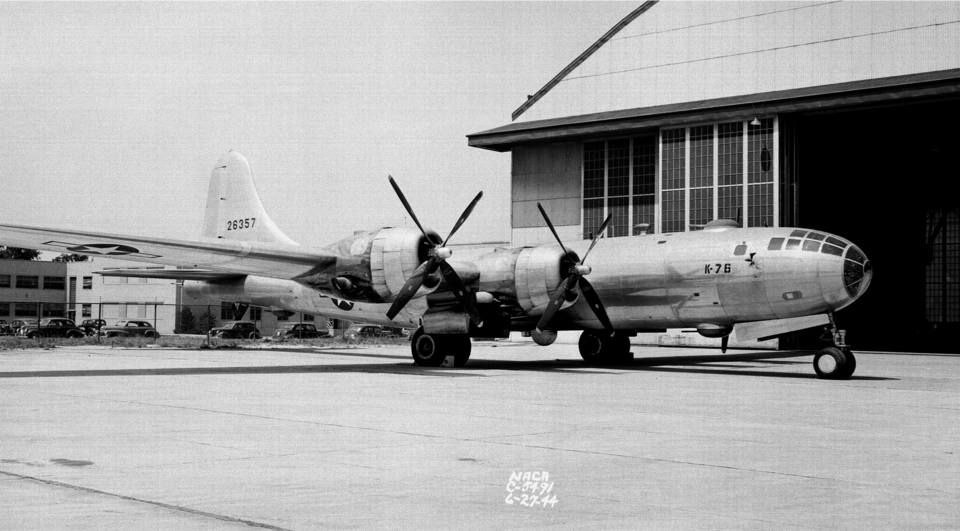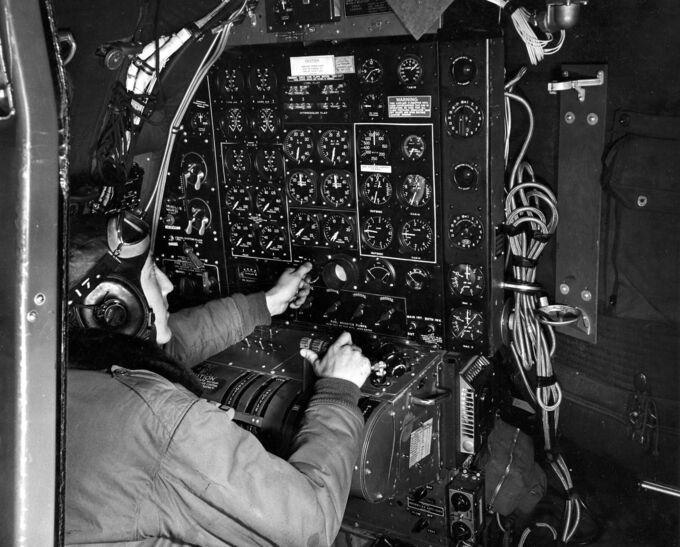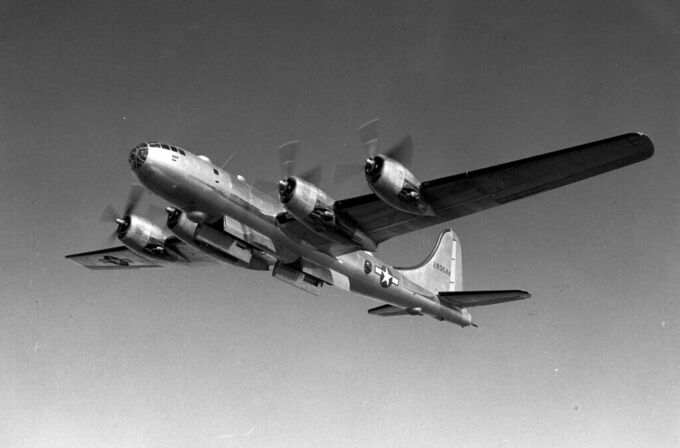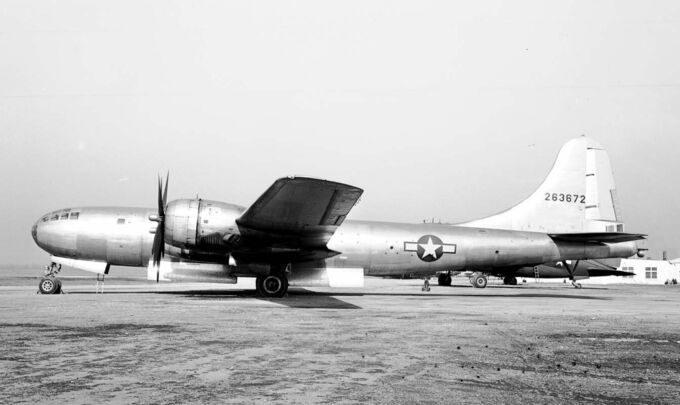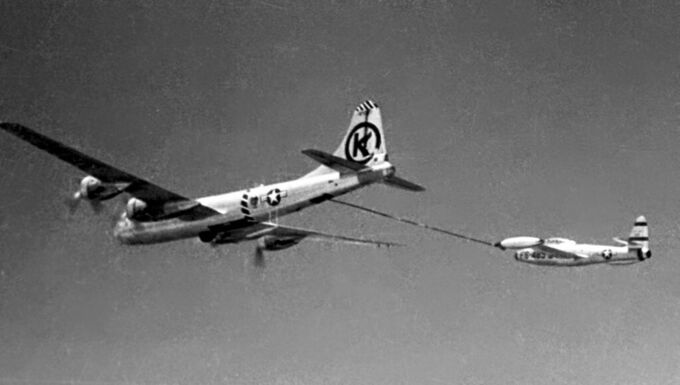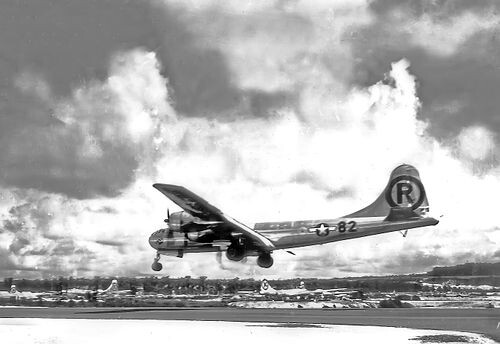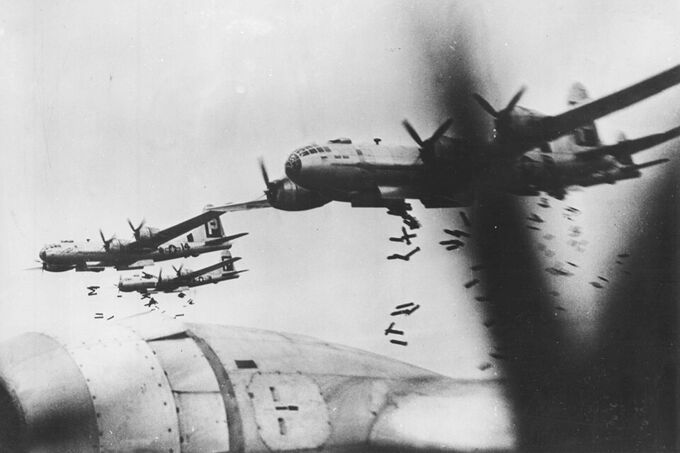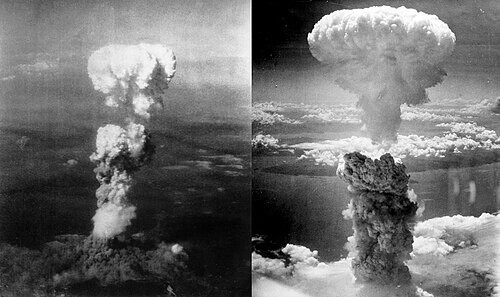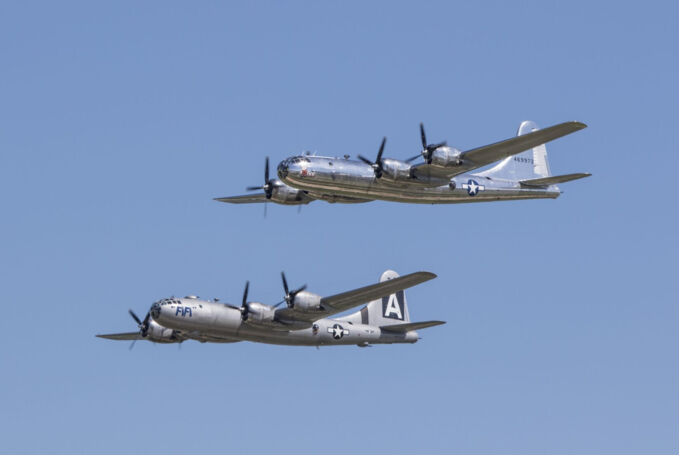The Boeing B-29 Superfortress was a revolutionary aircraft that redefined bomber aircraft and engineering during World War II. Designed as a long-range heavy bomber, it became synonymous with strategic bombing campaigns in the Pacific Theater, including the historic missions over Hiroshima and Nagasaki. With its advanced pressurized cabin, remote-controlled turrets, and ability to reach unimaginable altitudes and distances, the B-29 represented the peak of wartime aviation technology.
Design:
In the few years leading up to World War II, the United States Army Air Corps (USAAC) realized that its current primary heavy bomber, the B-17 would not have the range nor the payload which would be needed to efficiently transit what would end up becoming the Pacific Theater. To compensate for this, Boeing began to develop a prototype which would incorporate a pressurized cabin to allow for higher altitude flying, this would help to protect the bomber from Japanese fighters which struggled to get to such high altitudes. The USAAC had the requirements of the new plane going 400mph to a target 4,292 km (2,667 miles) and deliver a payload of 9,100 kg (20,000 lbs).
Development:
The resulting XB-29 prototype and the later production series B-29 bomber had everything the USAAC was looking for, leading the USAF to order 250 B-29s before they even took its first flight. Defensive positions on the B-29 were well placed to ensure maximum coverage surrounding the bomber, with a total of 12 Browning 0.50 caliber machine guns and one 20mm cannon at the rear, which was later removed. This bomber used the General Electric Central Fire Control system which could be used to remotely control four of the turrets (two dorsal and two ventral). These turrets had a General Electric analogue computer linked to them, allowing the weapons to be more accurate by automatically factoring in airspeed, gravity, temperature and lead time for the inbound aircraft. With this setup, the turrets could be controlled from almost any position. This led to an impressive kill/death ratio over the Pacific, with 969 Japanese aircraft being shot down for only 74 losses, a ratio over 10:1.
The B-29 also required a pressurized cabin to enable flying at high altitudes. Luckily, Boeing’s design team was ahead of other competitors as they had been working on the Model 334, a pressurized derivative of the B-17. Although the Air Corps stopped funding that design, Boeing continued developing it with its own funds as a private venture. In December 1939, when the Air Corps issued formal requirements for the so-called “superbomber”, Boeing’s previous private venture studies formed the starting point for its response to the Air Corps formal requirements. The controls for the pressurization system and many other systems would be located at the flight engineer’s station.
In the summer of 1943, following the development of the XB-29, the YB-29 was put into testing. These 14 aircraft would feature numerous modifications such as improved engines, four bladed propellers, a better fire control system and changes to the defensive armament. Changes to the armament were considered but were not put into production. Another YB-29 (this one would be later referred to as XB-39) was also used to test if the Allison V-3420-17 would be suitable for use, in case the Wright R-3350 radials were too problematic or had supply issues. This was not the case with the R-3350s but the Allison engines ended up being surprisingly successful, making the aircraft able to surpass 400mph.
Variants:
The B-29 had many variants, some more well known than others.
B-29A:
The B-29A was the most numerous variant, with 1,119 produced. It featured some defensive armament changes and its wing structure was made out of three sections compared to two sections, increasing strength and easing construction. Apart from these changes it remained very similar to the standard B-29.
B-29B:
The B-29B was a modification for a lighter, faster bomber for firebombing missions over Japan. This was achieved by removing some defensive turrets only leaving three 0.50 caliber machine guns. In addition a APQ-7 bombing-through-overcast radar was fitted. Only 311 B-29Bs were produced.
B-29D (B-50):
The B-29D (prototype XB-44 which led to the B-50 family), was a revision of the B-29, it would be the last piston-engined bomber produced by Boeing and had many improvements over the B-29. Improvements would include:
- Landing gear strengthened and takeoff weight increased from 133,500 pounds (60,600 kg) to 173,000 pounds (78,000 kg).
- Stronger engines, the Wright R-3350s were replaced with Pratt & Whitney R-4360 Wasp Majors.
- Improved flight controls.
- Large tail and rudder.
- Reinforced wing structure to allow for underwing fuel tanks.
Only 370 B-50s were produced.
KB-29:
The KB-29 was a modified version of the B-29, designed specifically for aerial refueling operations by the U.S. Air Force, the KB-29 was adapted to serve as a tanker aircraft, helping extend the range of other planes in flight. There were two main KB-29 variants:
- KB-29M: Used an early refueling system involving a looped hose method, which was somewhat cumbersome but paved the way for modern aerial refueling techniques.
- KB-29P: Featured a more advanced rigid flying boom system, which became the standard for future Air Force tankers.
A total of 282 B-29s were modified to the K standard.
There were also numerous testbeds involving all kinds of modified B-29s which were used from testing jet propulsion, parasite fighters and other new systems.
Silverplate B-29:
Silverplate was the codename for the U.S. Army Air Forces' involvement in the Manhattan Project during World War II, referring to modifications that enabled B-29 bombers to carry atomic bombs, such as removed weight and modified bomb bays to accommodate the larger bombs. Testing began in 1943, and the first modified aircraft, the “Pullman,” was used for flight tests in 1944. After the war, the program continued under the new codename “Saddletree,” modifying an additional 80 aircraft, though the final group, modified in 1953, never saw service.
A total of 65 Silverplate B-29s were made by 1947 and then 80 Saddletree B-29s were made.
Soviet Tu-4:
In 1945, three B-29s were forced to land in Soviet territory due to a lack of fuel. Since the USSR was not at war with Japan, the crews were interned but later returned, while the aircraft remained in Soviet hands. Stalin ordered Tupolev to reverse-engineer the B-29, leading to the Tu-4, which first flew on the 19th May 1947 and then entered mass production. Despite being visually similar to the B-29, the Tu-4 featured Soviet-made defensive armament, 23mm NS-23 cannons instead of the 0.50 caliber machine guns and was slightly heavier due to the lack of sheet metal in US customary measurements. This led to the bomber weighing 340kg (750lbs) more than its American counterpart. This bomber significantly advanced Soviet strategic capabilities, being able to replace the obsolete Petlyakov Pe-8. In 1951, the Tu-4 was used for the first Soviet air-drop test of an atomic bomb.
A total of 847 were built.
Combat Usage:
The Pacific:
The B-29 saw extensive use in the Pacific as its intended role for bombing Germany was aborted due to production delays. In the Pacific B-29s would carry out high-altitude strategic bombing campaigns against Japan. They would initially operate from bases in China and later from bases in the Mariana Islands like Saipan or Guam. However, bombing accuracy was questionable from high altitudes so under General Curtis LeMay’s command, B-29s began flying low-level nighttime incendiary raids, starting in early 1945 (This is where the B variant was used due to its faster speed).
Perhaps the most well known missions would be carried out on the 6th and 9th of August, 1945, by aircrafts Enola Gay and Bockscar. The 509th Composite Group was assigned for the mission, operating from the Tinian Island, who had practiced with dummy bombs known as “pumpkin bombs” and conducted several rehearsals.
On August 6th, 1945, Enola Gay dropped “Little Boy”, a gun-type uranium bomb, over Hiroshima. The bomb detonated at around 600m (1900ft) above ground with an approximate energy of 15 kilotons of TNT. An estimate of up to 140000 people were killed. Three days later, August 9th 1945, Bockscar dropped “Fat Man”, an implosion type plutonium bomb, over Nagasaki. The original target, Kokura was substituted for Nagasaki as the smoke from fire-bombing on Yahata and clouds obscured the aiming point. The second bomb detonated 500m (1650ft) above ground with an energy of 21 kilotons of TNT. An estimate of 60000 to 80000 people were killed.
Korea:
The B-29 also saw use in the Korean War, between 1950 and 1953, flying over 20000 sorties and dropping 200000 tonnes of bombs. However, B-29s were under threat of the new MiG-15 which could easily intercept slow, high altitude bombers.
Surviving aircraft:
22 B-29s exist too this day, two of them even being airworthy; FIFI (B-29A) and Doc (standard model B-29-70-BW), in which you can pay to take a short flight. FIFI belongs to the Commemorative Air Force and Doc to Doc’s Friends. There are also three Silverplate B-29s, one of which being Enola Gay and they are on display at the Smithsonian’s Steven F. Udvar-Hazy Center of the National Air & Space Museum.
Bibliography:
- Inch High Guy, “Boeing B-29 Superfortress Gunship” (2022)
- Inch High Guy, “Boeing XB-39 Superfortress” (2024)
- Mann, Robert A. The B-29 Superfortress: A Comprehensive Registry of the Planes and Their Missions (2009)
